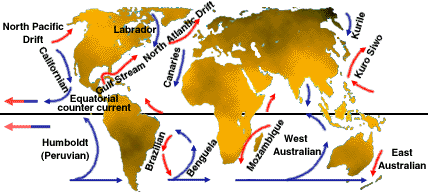The ocean floor is not flat. It is land and is as varied as the ground we live on.
Mountain Ranges: as magma erupts through the ocean floor, long chains
of mountain form. The longest chain is the Mid-Atlantic Ridge, located in the
Atlantic Ocean. Valleys in the ridge form deep canyons between mountains.
Seamounts: when a volcano erupts, isolated mountains called seamounts are formed
as the molten lava cools in the ocean water.
Guyots: as waves erode the tops of seamounts, they leave flat-topped mountains
called guyots.
Islands: some volcanoes or seamounts rise up from the ocean water and form islands.
Trenches: deep trenches form in between plates, when one plate is pushed under
another. The deepest of all trenches is located in the Pacific Ocean. It is hundreds of metres deeper than Mount Everest is tall.
Abyssal Plains: are the large, relatively flat areas of the ocean floor.
Water and Climate
Oceans, seas, lakes do affect the climate of of our world.
Proximity to Water
Large bodies of water affect the climate of a place. Coastal areas are cooler in summer and warmer in winter than inland areas. They usually receive more rainfall as well. The centre land area of continents generally have a greater range of temperatures. In the summer, temperatures can be very hot and dry and winters maybe very cold. Example: Toronto, Ont. - cold in winter, hot in summer; Vancouver, BC - mild in winter, warm in summer
Ocean Currents - see map
Warm Currents will cause the air above the water to be warmer than normal. The Gulf stream is warm thus when it travels across to Britain it causes the air there to be warm. If currents are cold then air passing over them will also be cold. If this air blows onto a city then consequently the city's temperature will drop because of this current.
Winds
Winds that blow from a warm body of water often bring warm temperatures and rain to the coast and dry weather to inland areas. Winds that blow from a cool body of water bring cooler temperatures and very often a desert-like area will be found along the coast.
Do the Great Lakes affect our weather?
On shore breeze - cools warm summer temperatures
Temperatures are usually cooler down by the lake
Often on shore breezes result in an increase in the precipitation -
(more rain in the warmer months and more snow in the winter months)
Name Area Average Greatest Place of
depth known greatest
depth known depth
sq. mi. sq. km ft. m ft. m
Pacific Ocean 64,000,000 165,760,000 13,215 4,028 36,198 11,033 Mariana Trench
Atlantic Ocean 31,815,000 82,400,000 12,880 3,926 30,246 9,219 Puerto Rico Trench
Indian Ocean 25,300,000 65,526,700 13,002 3,963 24,460 7,455 Sunda Trench
Arctic Ocean 5,440,200 14,090,000 3,953 1,205 18,456 5,625 77°45'N; 175°W
Mediterranean Sea 1,145,100 2,965,800 4,688 1,429 15,197 4,632 Off Cape Matapan
Caribbean Sea 1,049,500 2,718,200 8,685 2,647 22,788 6,946 Off Cayman Islands
South China Sea 895,400 2,319,000 5,419 1,652 16,456 5,016 West of Luzon
Bering Sea 884,900 2,291,900 5,075 1,547 15,659 4,773 Off Buldir Island
Gulf of Mexico 615,000 1,592,800 4,874 1,486 12,425 3,787 Sigsbee Deep
East China Sea 482,300 1,249,200 617 188 9,126 2,782 25°16'N; 125°E
Hudson Bay 475,800 1,232,300 420 128 600 183 Near entrance
Japan Sea 389,100 1,007,800 4,429 1,350 12,276 3,742 Central Basin
Andaman Sea 308,100 797,700 2,854 870 12,392 3,777 Off Car Nicobar Is
North Sea 222,100 575,200 308 94 2,165 660 Skagerrak
Red Sea 169,100 438,000 1,611 491 7,254 2,211 Off Port Sudan
Baltic Sea 163,000 422,200 180 55 1,380 421 Off Gotland





